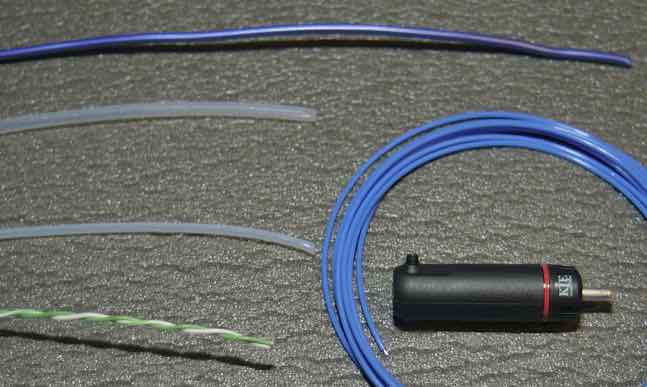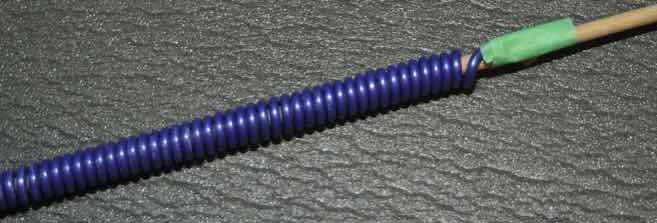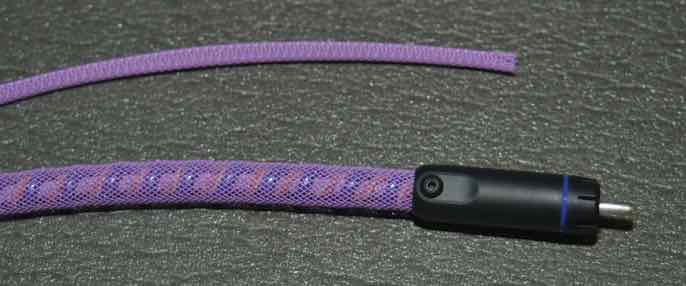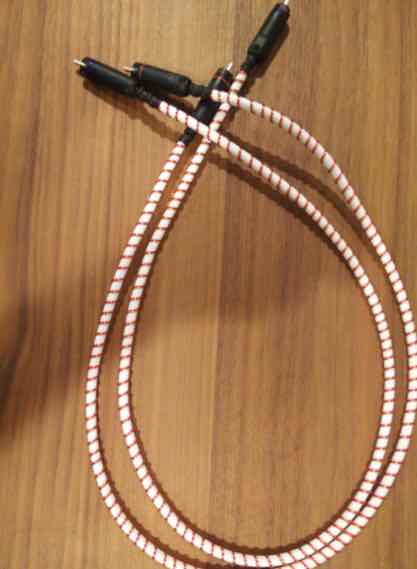DIY Interconnect Cables - The "Helix Mark V"
The premise behind its helical geometry (or architecture) is eliminating parallel conductors, since...
- if two parallel conductors are in close proximity for an extended distance, and current is passed down one of those conductors, then noise will be induced into the other conductor.
e.g. in a 120 volt mains cable I measured noise in an adjacent conductor of 42 volts!
In the case of “conventional” interconnect cable architectures, the signal conductor and the neutral conductor are side by side in extremely close proximity for the length of the cable, therefore in my mind, I consider it reasonable to assume that some noise, however small, will be induced from the signal conductor into the neutral conductor.
Why would this matter? Isn’t the neutral is effectively connected to the “ground” ?
Well, the neutral conductor is actually connected to the neutral side of the attached components’ circuitry.
On it’s way to “ground” it raises the potential on the neutral side of the components circuit, which has a negative impact on the amplified signal resulting in a distorted sound.
The helical design concept eliminates the parallel conductors and minimizes induced noise to imperceivable levels.
One other nice feature of the helical design is the neutral conductor, being wound around the signal conductor, becomes a very effective shield against external RFI sources - because it is connected to “ground” ![]()
But Shouldn’t The Two Conductors Be The Same Length?
If you look at the “roles” the two conductors play from the perspective of an attached components’ circuit diagram it becomes clear that not only can they be different lengths, but they can be made from different materials and gauges.

- The Signal Conductor transfers the signal
- The Neutral Conductor merely links the neutral sides of the two attached components
For more theory pertaining to this see Electromagnetic Interference - Considerations in Structured Cabling Systems from Siemens
So How Did I Construct Them?...
The parts list is reasonably priced between $180 - $250 CDN for a 3ft ( or 1 meter) pair, depending on the RCA’s selected and all other parts can be purchased from many parts providers on the web.
Considering their exceptional sound quality I believe this price range to be excellent value.
You can upgrade or downgrade these parts if you wish, but the parts listed will provide exceptional sound quality.
I use an approximate ratio of 3:1 of CAT6/Neutral:Signal conductor
e.g. for a 3ft Interconnect cable I use 9ft of CAT6 and 9ft of Neutral Conductor
The quantities listed is for a single Interconnect cable i.e. one channel - so double them for a stereo pair
- RCA Plug: KLE Innovations Absolute Harmony RCA Plugs (SOURCE: KLE Innovations or local parts sources)
- Neutral Conductor: 9 ft of Neotech UPOCC 20 AWG, Deep Cryo Treated (SOURCE: TAKE FIVE AUDIO - TFA)
- Signal Conductor: 3 ft of Neotech UPOCC Silver 28 AWG, Teflon Insulation, Deep Cryo Treated (SOURCE: TFA)
- Outer Teflon Tube: 3 ft of PTFE 10 Tubing .106"ID .130"OD Approx. (SOURCE: TFA)
- Inner Teflon Tube: 3 ft of 10 awg AND PTFE 14 Tubing .066"ID .090"OD Approx. 14 awg 1ft (SOURCE: TFA)
- Floating Shield: 9 ft of CAT5e or CAT6 twisted pair - obtained from a network cable (SOURCE: any computer store)
- WBT 4% silver solder

Why two teflon tubes?
- Two tubes provide a bigger “gap” between the neutral and signal conductors = less noise!
- In very tight radius turns, two tubes prevent “kinking” in the walls of the tubes.
Step 1.
The neutral winding is perhaps the most difficult aspect of this cable, but the choice of a solid core conductor maintains the helix shape and spacing, and allows for flexibility.
I first wind the conductor around a 6mm dowel. To assist with this I insert the dowel into a variable speed hand drill and feed the conductor along its length.
Once wound, the helix can be removed from the dowel, but you may have to loosen the helix (i.e. back-off the twist) a little to do so.

Step 2
Insert the teflon tube(s) into the helix.
Space the windings over the length of the tube
Tighten the helix by twisting it, about an inch at time, along the length of the cable

STEP 3
Next, install the “Floating Shield” CAT5/6 twisted pair.
What is a “Floating Shield” ? - it is a conductor that is attached to a “ground point”, in this case the neutral conductor, but only at one end of the cable. The other end is not connected - i.e. left “floating”.
Why do you need it? - it disrupts the ability for RFI/EMI to induce noise into the adjacent cables.
NOTE:
The end of the cable with the floating shield should generally be connected to the “source” of the signal. This prevents the transfer of any noise to subsequent amplification stages.
However, if that source component is equipped with an “isolated power supply” e.g. the Wal-Wart variety - then that end should be connected to a properly grounded component.
In the event both components are not properly grounded the direction of connection is arbitrary and you might want to experiment for best performance - in your system.
- First, solder the twisted pair to one end of the neutral conductor.
- Wind the twisted pair in between the windings of the neutral conductor.
- When you get to the end, simply cut it a little shorter and secure it in place with a glue gun or a small piece of electrical tape

Step 4
At this point I insert the assembly into the outer expandable sleeve and cut to length
- I mark the end of the cable that has the floating shield attached with a piece of masking tape
I then place the RCA housing on the cable
Insert the signal conductor into the teflon tube
(hint: cut the wire to length and strip the wire before inserting - it’s easier)
Solder on the RCA plugs and attach the RCA housing to the body and tighten the set screws in the housing
I then place a piece of heat shrink over the RCA housing to indicate which end the floating shield is connected to the neutral.

Assembly Notes...
I purposely did not specify which expandable sleeve to use because it is a personal preference. However, using the neutral conductor identified above requires the use of a thin expandable sleeve (like the one above) in order to get the RCA housing over the cable.
- If you would like to use a thicker sleeve you can use a teflon insulated neutral conductor, which has a thinner insulation. It will NOT effect the performance of the cable, but it is a little more expensive.
If you do not like the sound of a silver signal conductor you can use a 24 gauge UPOCC copper conductor. The sound will not be quite so bight and dynamic, but the other properties (clarity, image, bass, bass control) of the cable are still exceptional.
Warning:
The 28 gauge centre conductor can be subjected a lot of stresses causing fractures if the cables are frequently handled or subject to multiple tight radius turns.
To overcome this simply perform the following steps:
- wind the signal conductor tightly around the dowel
- straighten it out using your fingers only. you will be left with a conductor with multiple little kinks
- after placing the neutral conductor around the teflon tubes remove the inner teflon tube
- Insert the signal conductor in the larger tube only (you may require a pull-through)
The “spring” in the kinks will ensure the signal cable does not fracture
Can you use other brands of RCA?
NOT RECOMMENDED!
I recommend KLE Innovations Harmony RCA’s because of their stellar performance. Personally, I use the Absolute Harmony RCA because it is their best performer.
The properties of the KLEI Harmony RCA’s are very different from conventional RCA’s, such that they can be used on single ended SPDIF cables without experiencing the issues associated with conventional RCA’s not rated at the same impedance as the cable because their impedance exceeds 110 ohms.
e.g. “convention” states that a SPDIF cable should use an RCA plug of identical impedance
Primarily to reduce/eliminate internal “reflections” of the digital signal back down the cable
However, the KLEI Harmony RCA’S can be used on most digital cables regardless of the cables rated impedance value.
I also believe their higher impedance is responsible for their stellar analogue performance.
Can this cable be used for SPDIF purposes?
Absolutely! - it is an extremely adept SPDIF cable!
And I have found that the following cost saving adjustments do not impact SPDIF performance at all...
- KLEI Pure Harmony RCA plugs can be used in place of the more expensive Absolute Harmony RCA plug
- The silver signal conductor can be replaced with an UPOCC copper conductor
To date, it is the best SPDIF cable I have used.
What do they sound like?
The “Helix Mark V” is a high performance interconnect cable with extremely high resolution abilities.
They deliver a completely “uncoloured presentation” with ultra fast dynamic performance, exceptional clarity, expansive imaging and a very deep and exceptionally well controlled bass performance.
They excel in the delivery of one of the most realistic presentations of live recordings I have observed.
- The delicate nuances pertaining to the acoustic reverberations of instruments and voice within a live venue are faithfully reproduced in the most minute detail, with a precision placement of musicians and their instruments within their own “virtual space”.
My system components are quite modest by today’s standards. However my cables are all excellent performers and they work in harmony with the components to achieve an excellent overall “system performance”.
Will the “Helix Mark V” perform well on all systems?
Based on my observations of previous versions on a couple of other systems, I have no reason to believe their performance will be anything less than stellar.
The Journey...
I’m a frugal person with a distinct dislike of overpaying for something as simple as a piece of wire!
I started making my own cables many years ago, but many of those utilized bulk cable from companies like Van den Hul and DH Labs.
I then investigated some of the more recent cable geometries such as tight twisted pairs, braiding and helix geometries.
My biggest issue with helix designs as a DIYer - how to maintain a uniform distance between the signal and neutral conductors - the teflon tubes alleviated this problem
My primary goal along the way was to keep the cost of materials to a minimum - hence the initial use of the CAT6 for the neutral conductor.
When I first tried the helix design it was quite clear that it was going to be a very adept performer, despite my cost saving CAT6 measures.
This observation supported my belief that the helix architecture (or geometry) was an extremely effective approach to achieving excellent cable performance.
The early versions utilizing CAT6 as the neutral conductor were very good - just not brilliant!
With the “Helix Mark IV” version, I decided to incorporate higher quality materials in the neutral conductor in the hope that I could come even closer to the performance levels of some of todays popular high performance cables for a fraction of the cost.
The improvements were so good and based on my earlier versions that performed better with multiple strands of CAT6 for the neutral, I concluded that a larger gauge neutral conductor would provide additional improvements - and...
Voila, the “Helix Mark V” was born!
The result:
a cable that actually competes with some of the very best cables in the audio world!
C’mon, Really?
- OK, I’ll let you be the final judge, but after listening to many cables I believe this to be the case

How Long is the Burn-In Period?
It is imperative that these cables are allowed adequate time to settle and burn-in, which is typically >300 hours.
- they will however sound extremely good on initial installation
- they may exhibit some loss in volume after 3-4 days continuous use, which will return to normal by day 6-7
- they may exhibit some bass “blooming” around day 6-7 also, this will return to normal in about 30 hours
- they will sound exceptional after around 200 hours, but they will get even better after 300 hours
- I have also found ongoing improvements occur up to approximately 600+ hours in the earlier versions
- The use of cable cookers will expedite this process - start with 100 hours cooking + 100 hours playing
The end of the Road?
I have decided to end this particular interconnect cable “obsession” with the “Helix Mark V” simply because...
- the cost of better materials is making them significantly more expensive
- the improvements using better materials will probably be marginal from this point onwards
My hope is that this design will be embraced and enhanced by the DIY Community and encourage them to experiment with different conductor materials to tailor the sound to their own liking.
My Review System:
Custom built turntable with a Soundsmith Denon DL103 phono cartridge mounted on an Audiomods Arm with one piece silver litz harness + KLEI Absolute®Harmony RCA’s
Simaudio MOON LP5.3 RS phono stage
Bluesound Node 2 music server
NAIM 5i integrated amp (with passive pre-section).
Gershman Acoustics Sonogram speakers.
KLE Innovations gZero6 Speaker Cables
Assorted power cables
 Give them a try - and - Enjoy The Music!
Give them a try - and - Enjoy The Music! ![]()
ADDENDUM:
Audiogon Member Toddverrone has also tried these IC’s ...
The Parts List :
- signal wire: OCC solid silver 24awg in cotton. 3' per cable
- neutral: OCC solid copper 20awg magnet wire. 2 x 9' per cable
- connectors: KLE pure harmony solid silver
- the white tube is a foamed teflon flexible tube that i ran the signal through. it's pretty amazing. it doesn't kink at all. it's called hyperflex tubing from vh audio
Todd’s Feedback...
I’m still listening to them, but initial findings on the helix ICs are incredibly positive.
More of the helix magic: less noise, greater clarity, better separation of sound sources.
Good stuff!



